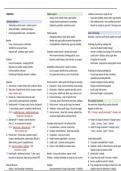MARKETING Market research Confidence intervals are a margin of error
- Analysis of info, identify trends, opportunities - Assess data reliability, answer within range (uncertai
Marketing objectives - Compare business performance to competitors - High confidence levels = more confident (normally 95
> Anticipating customer wants – market research - Explanatory, predictive, exploratory reasons - Depends on sample size, pop size, % choosing answe
> Satisfy and delight – marketing techniques
> Meeting organisation needs – aims/objectives Market mapping Value of technology
- Distinguish position in matrix (price, quality) Drawbacks – expensive, staff retrain, quantity over qualit
Benefits - Identify rivals, gaps, public perception, help reposition
- Focus, common purpose, coordination - Oversimplification, subjective bias, gaps not profitable Technology in gathering marketing data
- Yardstick for success and failure - Access to info about (modify strategy)
- Motivate staff – ambitious target + priority Qualitative market research = opinions and reasons - Internet = unreliable, broad range of info, search eng
- Why consumer behaviour, thinking patterns, issues - Loyalty cards = database, tastes, target offers
Problems - Expensive, need interpret, small scale bias, no compare - Competitor info accessible
- Incorrect assumptions – changing PESTLEC - Social media – target promos, demographic, interest
- Objectives may conflict, unclear priorities Quantitative market research = based on numbers
- Not have sufficient resources - Easy to compare, identify trends, predict future Technology in analysing marketing data
- Demotivated if objectives imposed + ambitious - Not explain why trends occur, bias if small sample - Process large amounts of data, correlations,
- Quantitative forecasting efficiently
Objectives Primary research = collect specific info (fill gaps in secondary) - Compare strategies to improve planning
1) Sales volume = number of items sold / produced, diverse 1) Experiment – cheap, customer behaviour, delay strategy - Changes in trends detected quickly
2) Sales value = financial worth of items, revenue, compare 2) Observation – behaviour, expensive specialist, not why - Loyalty cards tailor services
Value = volume x price 3) Focus group – identify why, ideas, bias as interest, cost - Data stored cheaply + accessed quickly
3) Market size = volume/value shows max sales 4) Personal interviews – range of qual info, time
Larger market, greater opportunity, competition consuming, answer influenced by interviewer, leading qs Price elasticity of demand
4) Market growth = % change in sales of sector, fast growth 5) Postal surveys – cheap, specific target, low response How much price change affects quantity demanded
↑ value/volume, expand = competitive, identify trends 6) Telephone – cheap, specific target, reluctant to engage Negative not affect value
MG % = market size in year – market size prior year 7) Internet surveys – cheap, high response, updated, bias PED = % change in quantity demanded / % change in pric
Market size in previous year as interest, target audience not have internet
5) Sales growth = % change in sales for business <1 = inelastic (% change in demand < % change in price)
Aim to ↑, in recession aim to maintain Secondary market research = info collected other ↓ price ↓ revenue, ↑ price ↑ revenue
SG % = sales in year – sales prior year x 100 1) Gov publications – economic, social trends >1 = elastic (% change in demand > % change in price)
Sales in previous year 2) Company records (internal) – cheap and accessible ↑ price ↓ revenue, ↓ price ↑ revenue
6) Market share = % total sales of product, target %, 3) Competitors – study rival’s actions
compare, identify position, market leader, difficult to 4) Market research organisations – buy surveys Factors influencing PED
define market, grows if competitor leaves 5) Loyalty cards – customer spending patterns 1) If a product is essential/habit = inelastic
MS = sales of a product / company x 100 6) Internet – lack reliability as not know source 2) Substitute = elastic, no alternatives buy similar quanti
Total sales in market depends on what is viewed as similar
7) Brand loyalty = attachment to brand, ↑ sales, repeat, Benefits – cheap, quick decisions, regular = trends 3) Brand loyalty = inelastic
less spent on ads/promo, higher price as inelastic PED Problems – outdated, misleading, no comp adv, not accurate 4) Cheap items take small % of income = inelastic
5) Income, wealthy less worried = inelastic
External influences Sampling 6) Time, changes have less impact on short term as time
- Political – limit advertising + international - Data representative of target, large samples ↑ reliability needed to search for alternatives = inelastic




